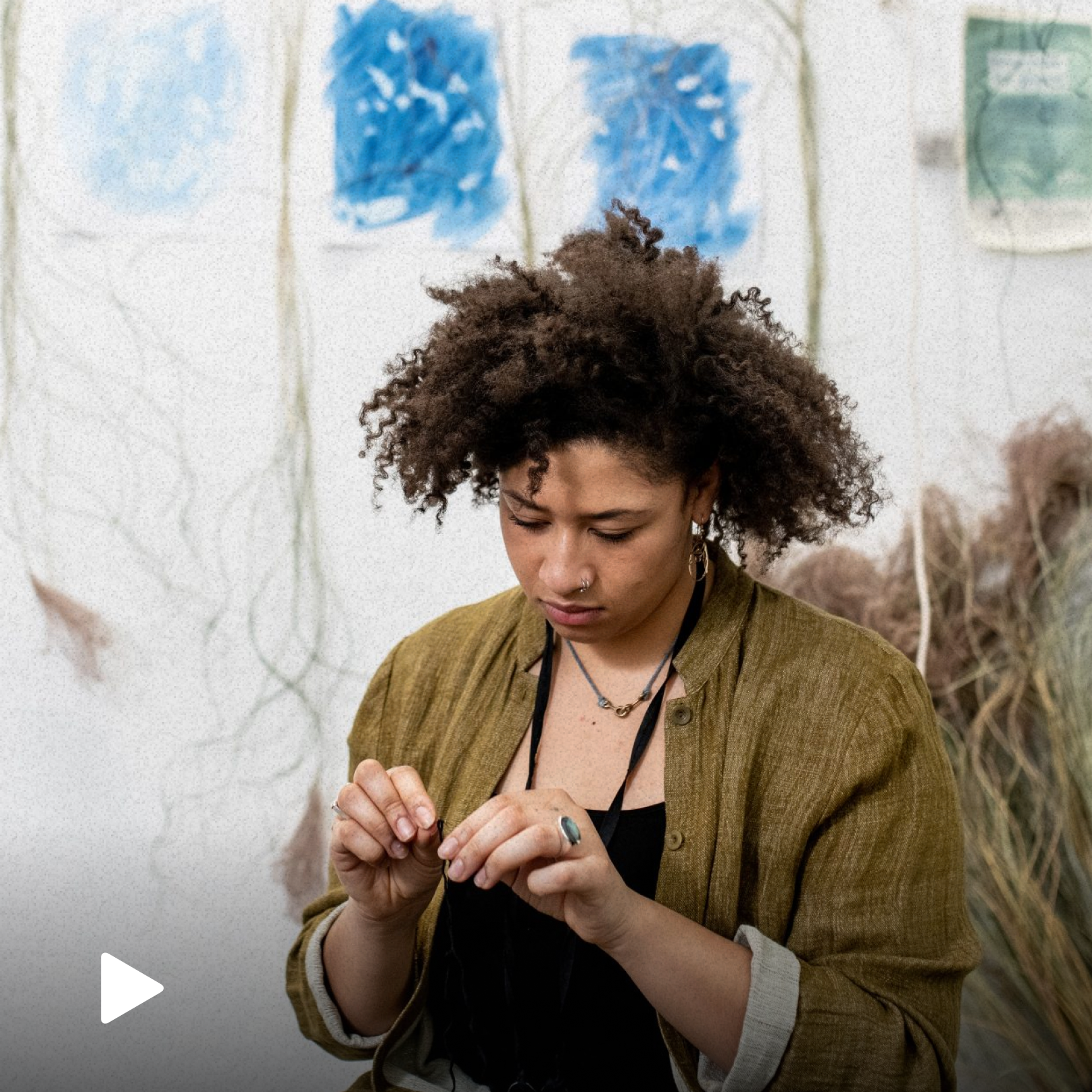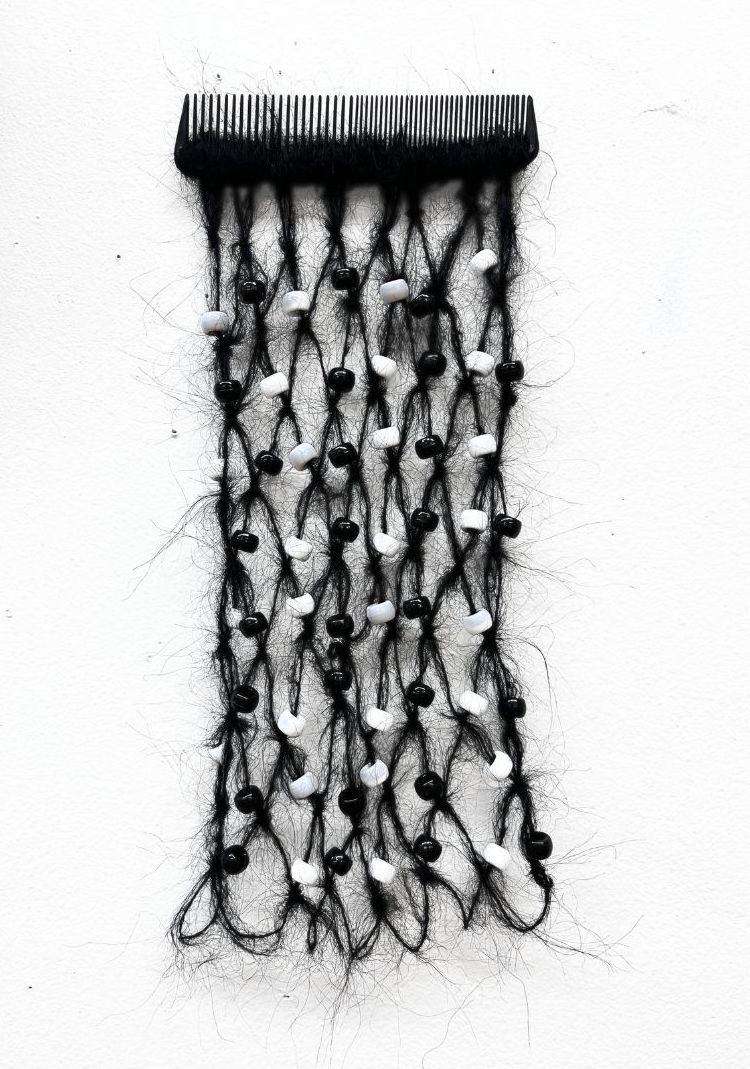Conversation with Ashley Page
Interview with the recipient of the November edition of MyMA Artist Grant, Ashley Page.

Congratulations for winning the November MyMA Artist Grant! Can you tell us a bit about yourself and your practice?
Such an honor! My name is Ashley Page, I’m an interdisciplinary artist based in Portland, Maine but originally hailing from Minneapolis, MN. In my work, I explore the vulnerability, grace, and complexities of the Black experience. I consider my creative practice to be a vessel for representation and visibility. In my work I have been utilizing textile/fiber techniques such as netting, weaving, twining, coiling and crochet to create mixed media sculptural basketry forms. These vessel forms are often a metaphor for the body, a vessel for a spirit, or act as a container for ephemera. With these vessels, I consider the universal cultural context of a basket and their functional place in human history, while using them as the vehicle for memory, portraiture, and storytelling.

In your statement, you mention that vessels in your work often serve as metaphors for the body, a spirit, or containers for ephemera. Can you elaborate on the significance of these metaphors in your art?
Of course! I consider my work to be a reflection of the world around me and in an attempt to reconcile that world, I create artwork about my experiences and use my practice as a vehicle for storytelling. And fundamentally, I understood that my experience was shaped by my external appearance, my nationality, and the social caste system that plaques the country of the United States. And thus, I began to make work that addressed the physical body that I inhabit, as well as the multifaceted nature of humanity. Knowing that we are composed of several bodies (the emotional, mental, spiritual) and that we are also inhabitants of a larger, Earthly body, which is a part of an even larger celestial body. So that thinking is what brought me to creating vessels, which are largely sculptural basketry works. Utilizing paper, wire, fiber, hair, shells, beads, etc, they function as a metaphor for the various bodies that cohabitate amongst one another.

Can you tell us a bit about what drew you to start using fiber and textile in your sculptural practice?
I always say that Printmaking was my first love, but Sculpture moved in and didn’t leave room for anything else. But I recognize that I’m really drawn to process based techniques, things that require many steps, and transform over time. And even in my printmaking, I was printing on fabric to create installations, or as a textural element in something. But fiber and textiles became a primary fixture in my practice in Undergrad, when I took a few classes in the Textile and Fashion Department at Maine College of Art & Design. It was there that I discovered the magic of fabric manipulation, sewn forms, and textile construction. But it was in the Sculpture department (which was my major) that I was given the freedom to explore how those things were applied in a sculptural, conceptual framework.
In your statement, you also mention that growing up in a multi-racial home influenced your work and peaked your interest in mixing materials and techniques. Can you elaborate on how this experience influenced your art?
Growing up, I witnessed a merger of different backgrounds and upbringings, my dad being from a huge African American family with deep Southern roots and my mom being from a small family with German and Irish ancestry. Early on, I recognized the difference between family dynamics and loved the distinctiveness in which people lived, created community, and experienced the world around them. So I celebrate my family as a whole. And that pride and celebration carries itself into the work by giving me the freedom to explore, to merge ideas, truths, and materials. It’s a recognition of the multifaceted nature of my upbringing and who I am as a person.

How do you hope viewers engage with your art? Are there specific emotions or thoughts you aim to evoke?
I hope to inspire a feeling in whoever my viewer is. I want audiences to feel seen, recognized, curious, inspired, angry- anything. If I’ve sparked something in someone- that’s a win.
Do you have any studio rituals?
I don’t know that I call it a ritual, but I dance in my studio a lot. Sometimes I just need to shake up my energy, and other times I’m in a really good groove and a good song comes on and suddenly I’m dancing around the studio.
What’s the first thing you do when you enter the studio?
Before anything, I take my outdoor shoes off and switch into my studio crocs. They’re dark green, covered in paint, paper pulp and whatever else but as soon as I put them on, I know it’s studio time.

What do you listen to in the studio? If anything.
When I listen to something, I’m usually switching between an audiobook, music, or a podcast. But honestly, sometimes it’s just nice to work in silence and zone into the work.
In addition to being an artist, you are also a prolific curator. How did you get into curating?
I consider curatorial work to be a bridge outside of my studio/gallery and into communities. It started when I was in Undergrad, fulfilling a Warren Public Engagement Minor, and I started collaborating with my (now) very close friend, Alejandra Cuadra, who was another Fellow at the time. In working together we developed a manifesto and framework of representation, diversity, equity, justice and inclusion, upon which our public engagement work would be built.
The first show I ever did was a project that Alejandra and I co-curated called Resilience of the Human Spirit in partnership with the Abyssinian Meeting House in Portland, ME. The Abyssinian Meeting House is a vernacular wood-frame building constructed between 1828 and 1831 to serve Portland, Maine’s African American community. Remodeled by the Congregation in the decade after the Civil War, it was used for religious, social, educational, and cultural events until its closing in 1916. Eight years later the structure was substantially renovated into tenement apartments, which were occupied continuously until the building was condemned by the City of Portland in 1991. In 1998 the former meeting house was sold for back taxes to the Committee to Restore the Abyssinian, a non-profit organization formed to preserve and restore the structure. And in April of 2019, they opened their doors and allowed us to fill the space with artists of all disciplines who opened up conversations surrounding hope, perseverance, and the human spirit.

How does your curatorial experience weave into or influence your artistic practice? If it does.
It absolutely does- Being an artist and a curator feels like such a privilege. When I am looking to put together an exhibition, I love having studio visits because I can talk with artists about the work they’re making or the ideas they’re considering and I can relate to the conversation on a personal level. And in those moments, I have thoughts like “Oh you’re thinking about XYZ… you should meet so and so, because they’re also thinking about it” and I use group shows or artist talks, or meet ups to facilitate those relationships and community connections.
How do you overcome creative blocks or challenges when working on a piece?
Honestly, I don’t find myself in creative blocks very often, but I do a lot of writing in my studio. Sometimes it’s just free writing that doesn’t make a lot of sense, and other times it's short prose poetry, but writing really helps me free up my flow of thinking.
If I feel like something is missing in a piece, I will ask myself “How can I make it sexy?” And not in an objectifying male-gaze way, but I’ll add or subtract things such as colors, textures, materials- things that make the work more fantastical or intriguing.
How do you spend your time outside of the studio?
I work at an artist residency, called Indigo Arts Alliance as their Studio and Programs Manager. As for my free time- I love to cook, so you’ll find me in a local market or grocery store. I also love going out to a good dance party, or meeting up with friends and just enjoying each other's company.

Is there a movie or book you’ve felt particularly moved by recently?
Even though my reading of it wasn’t recent, Octavia Butler’s Parable of the Sower feels omnipresent.
What’s your go-to karaoke song?
These Boots are Made for Walkin’ by Nancy Sinatra
What’s the best advice you’ve ever received?
No matter what circumstance you’re in, you have to make things work for you.
